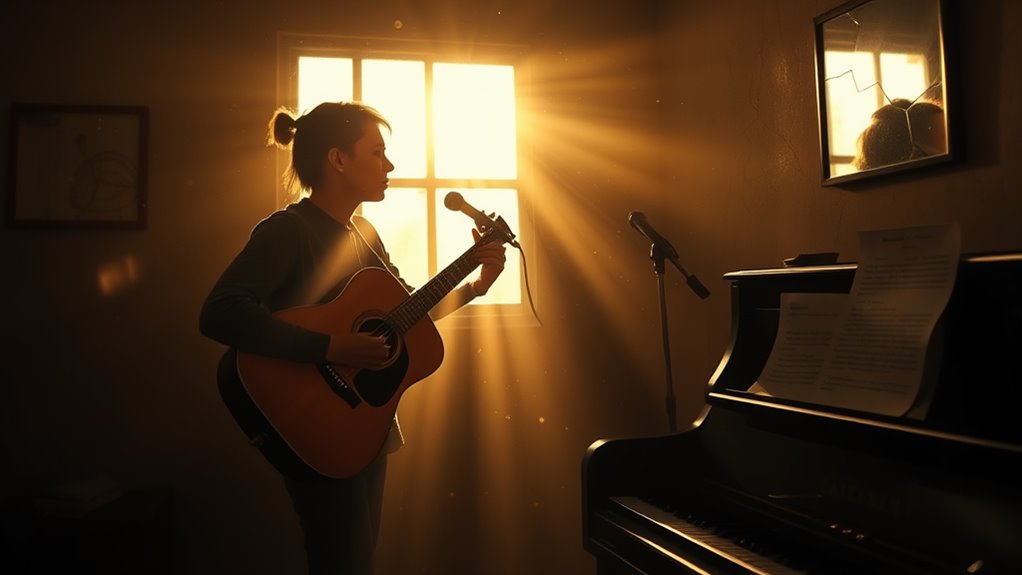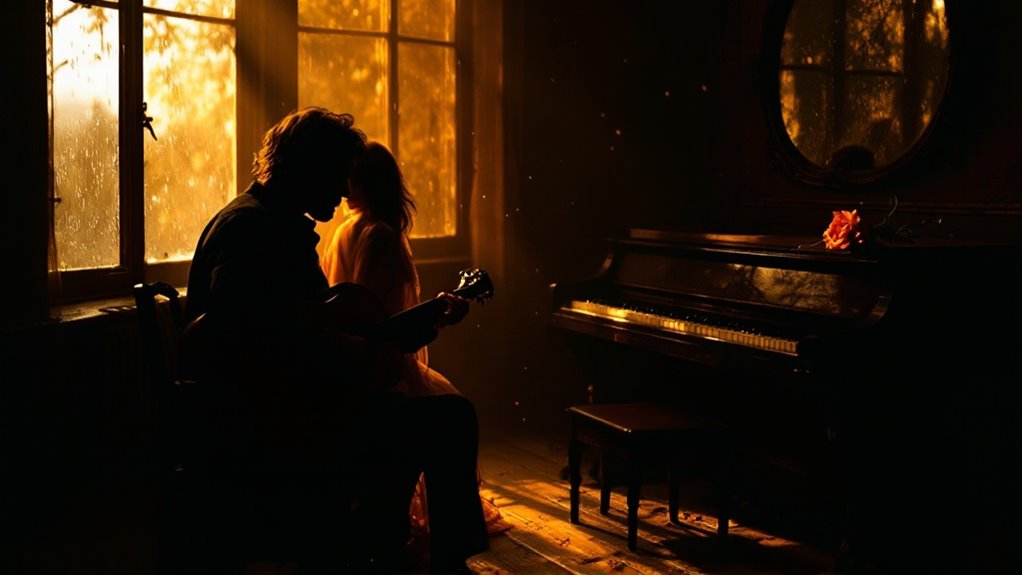David Gilmour's "Yes, I Have Ghosts" weaves spectral metaphors and raw emotion into a haunting reflection on memory and loss. You'll hear ghosts as lingering regrets, not just spirits—unresolved relationships or dusty dreams that cling tighter than any phantom. Ethereal harmonies with daughter Romany mirror shared history, while Polly Samson's lyrics (inspired by her novel) spin natural imagery like fragile thistles or moonlit dances to evoke life's fleeting beauty. The sparse harp and guitar? They're the quiet ache beneath the poetry. Stick around—there's more haunting depth to unpack here.
Key Takeaways
- Explores unresolved emotional hauntings through spectral metaphors like lingering ghosts, severed bonds, and decaying aspirations, blurring life and memory.
- Natural symbols (train whistle, thistle, moon) evoke transience, reflecting human fragility and cyclical existence.
- Collaboration with daughter Romany amplifies intimacy, mirroring lyrical themes of shared history and familial connection.
- Sparse instrumentation (harp, guitar) and spectral harmonies enhance ethereal melancholy, echoing existential introspection.
- Lyrics inspired by Polly Samson's novel *A Theatre for Dreamers*, weaving personal and universal grief into ambiguous, relatable narratives.
Ethereal Imagery Breakdown
Spectral Imagery & Liminality****
- *Heat of sun creating night specters*: Juxtaposes warmth with haunting, suggesting intangible phantoms birthed by light's absence.
- *Station as liminal space*: Represents transitional states (life/death, memory/present), amplifying unease through unresolved movement.
- *Strangers playing games with sight*: Implies perceptual deception, blurring reality and illusion.
- *Baby in another's embrace*: Symbolizes severed bonds or lost innocence, haunting through absence.
- The haunting whistle of the train serves as both a literal signal and a metaphor for unseen transitions, echoing the persistent presence of the spectral amidst the mundane.
Ghostly Presence & Existential Haunting
- *Ghosts not all dead*: Living hauntings—unresolved relationships, regrets, or fractured identities—linger more acutely than spectral figures.
- *Dreams turned to dust*: Metaphor for eroded aspirations, haunting as unfulfilled potential.
- *Spinning thoughts in head*: Mental ghosts, cyclical anxieties or memories that trap the psyche.
Temporal Metaphors & Transience
- *Train on tracks symbolizing time*: Linear progression contrasted with *unfastening rails from mapless past*, suggesting liberation from chaotic history.
- *Teeth of zip representing moments*: Each interlocking "tooth" as a discrete, fleeting instant.
- *Slider moving down as life progresses*: Irreversible descent toward mortality, underscored by *bed as final resting place*.
- *Joined at hip*: Ambiguous past connections—relationships or selves—that resist separation.
Natural Imagery & Ephemeral Resolutions
- *Thistle blown on breeze*: Fragility of existence; souls adrift, untethered.
- *Moon illuminating ghostly dance*: Celestial light revealing transient, spectral beauty in darkness.
- *Millstones white as sheet*: Dual symbolism—burdens ("millstones") bleached into spectral relics or purity masking decay.
- *Haunting ending with resolution*: Paradoxical closure, accepting ghosts as part of existence rather than exorcising them.
Ambiguities & Open-Endedness
- The nature of "ghosts" (literal, psychological, or metaphorical) remains fluid, inviting interpretations of grief, memory, or existential duality.
- Unfastening rails leaves unclear whether this signifies freedom or disorientation.
- *Joined at hip*'s unresolved connection blurs boundaries between self and other, past and present.
- The attribution of the lyrics to Polly Samson's pen may explain the departure from Gilmour's previous thematic complexity, leaning into a more whimsical, storybook sensibility that polarizes listeners expecting his signature existential depth.
Recurring Themes
- Liminality: Spaces and states of in-betweenness (stations, dusk).
- Temporal Entrapment: Time as both linear (train) and fragmented (zip's teeth).
- Haunting by the Living: Emotional residues eclipsing death's finality.
- Natural Transience: Cycles of growth and decay mirroring human ephemerality.
The lyrics weave ethereality through unresolved tension—acknowledging ghosts while leaving their dominion ambiguous, balancing dread with melancholic acceptance.
Vocal Harmony Dissection
Contrary motion appears sparingly, introducing harmonic tension that resolves into unison phrases at pivotal moments (e.g., "Yes, I've ghosts"), grounding the song's abstract themes.
Call-and-response exchanges between verses evoke a dialogue between generations, while strategic silences after harmonies amplify their lingering emotional resonance. Diatonic harmony principles guide these interactions, ensuring the layered vocals align cohesively with the song's key and chord progressions.
The restrained dynamics and precise pitch control sustain a fragile, dreamlike quality, ensuring the vocals—not instrumentation—carry the weight of the song's meditation on absence and connection. Subtle EQ adjustments in the layered vocal mix enhance clarity without sacrificing the track's ethereal texture, further emphasizing this balance.
Collaborative Origins Exploration

"Yes, I Have Ghosts" emerges as a distinctive entry in David Gilmour's discography, marking his first solo release in five years and reflecting a deeply personal collaboration shaped by unique circumstances. The track's origins are rooted in familial and creative partnerships: Gilmour's daughter Romany contributes ethereal vocals and harp, while his wife, Polly Samson, penned lyrics inspired by her novel *A Theatre for Dreamers*, set amid Hydra's 1960s bohemian enclave.
This literary connection situates the song within a narrative of artistic idealism, echoing the novel's portrayal of poets like Leonard Cohen and the transient beauty of creative communities.
The lockdown's constraints catalyzed the collaboration, as canceled sessions led Gilmour to enlist Romany, resulting in a sparse, intimate arrangement that contrasts with Pink Floyd's layered productions. Their partnership was further nurtured through lockdown live streams in 2020 and 2021, which provided a platform for spontaneous musical experimentation. Their familial vocal blend—described by Gilmour as uniquely harmonious—adds emotional depth, while John McCusker's fiddle and Damon Iddins' string sampling infuse folk textures, diverging from Gilmour's rock roots. The track was officially released as a single by Sony Music on July 3, 2020, after initially being part of the novel's audiobook.
Thematically, the song's title and lyrics evoke lingering presences—artistic ghosts of the past or personal memories—aligning with Samson's exploration of legacy and impermanence. Released initially as part of the novel's audiobook, the track bridges literature and music, later finding a place on *Luck and Strange*'s CD/Blu-Ray editions, suggesting its dual role as both a standalone piece and a thematic extension of Gilmour's evolving solo work.
This collaboration underscores a shift toward introspection and familial artistry, distinct from his broader catalog yet resonant with the enduring influence of shared creative journeys.
Metaphorical Layers Unveiled
The article unpacks "Yes, I Have Ghosts" through multiple lenses. The ghosts symbolize unresolved memories and regrets, with "not all of them dead" reflecting how living relationships linger as emotional burdens. Dust and spinning imagery evoke fading, cyclical thoughts, while station and train metaphors frame life as a journey marked by changes (barriers, unfastened rails). The moonlit dance blurs reality and memory, mirroring the song's temporal ambiguity.
Emotionally, specters of strangers and shame point to alienation and self-reproach, while the "widening gap" and lost "sweet soul" underscore nostalgia and disconnection. Existentially, ghosts and thistles signify life's transience, "killer, my friend" confronts mortality, and millstones embody the weight of fate.
My interpretation synthesizes these layers: the song is a meditation on memory's haunting persistence, where personal regrets intertwine with universal existential dread. The collaboration with his daughter Romany Gilmour brings a deeply personal dimension to the track, intertwining their voices to reflect shared history and emotional resonance. Gilmour's sparse, haunting instrumentation—gentle guitar, spectral harmonies—echoes the lyrics' ethereal melancholy, creating a soundscape that feels both intimate and vast.
The cyclical structure of the music mirrors the lyrical spinning, evoking a mind trapped in recursive reflection. Contextually, Gilmour's introspective style amplifies themes of aging and reckoning, framing ghosts as companions in a solitary journey toward acceptance.
Ultimately, the song thrives in ambiguity. Its metaphors resist singular readings, allowing listeners to project their own ghosts—whether lost loves, faded selves, or mortality's shadow. This richness lies in its interplay of personal sorrow and existential resonance, making it a mirror for the listener's own unresolved echoes.
Frequently Asked Questions
Was the Song Released as Part of an Album or a Standalone Single?
You command attention: it's a standalone single, not an album track. You might question later physical releases, but they're strategic expansions reinforcing exclusivity. Gilmour controls distribution, prioritizing artistic authority over conventional formats since July 2020.
Has David Gilmour Performed This Song Live in Concert?
You've heard it stripped-down in livestreams, but Gilmour hasn't released full concert versions. With the track now on 2024's album, seize the chance to demand its live debut—power lies in shaping what stages amplify next.
Are There Any Official Music Videos for "Yes, I Have Ghosts"?
Strike gold—you'll find three official videos: a 2020 4K Greek-island visual feast, a 2021 intimate Von Trapped livestream, and a 2022 lyrics video. Each amplifies the track's haunting beauty, sharpening its emotional blade without flinching.
What Instruments Are Featured Prominently in the Song's Arrangement?
You hear Gilmour's classical guitar command the melody while Romany's harp weaves ethereal textures. Their voices intertwine, bolstered by McCusker's fiddle and a sampled string quartet—sparse yet potent, anchoring the track's haunting, intimate power.
How Long Did It Take to Write and Record the Track?
Like a storm reshaping landscapes, you forge swiftly. The track took weeks—penned as lockdown loomed, recorded rapidly. COVID's urgency thrust Romany into vocals and harp; Gilmour's focus harnessed chaos with a director's precision.


Leave a Reply